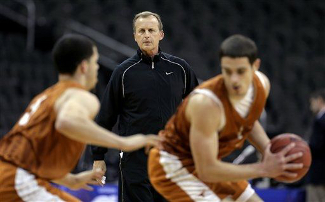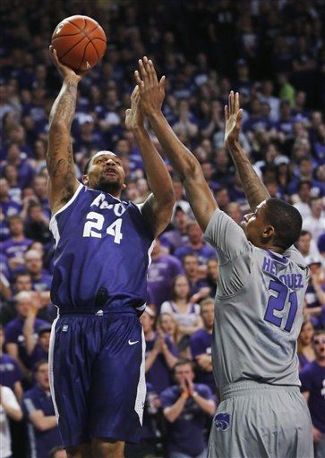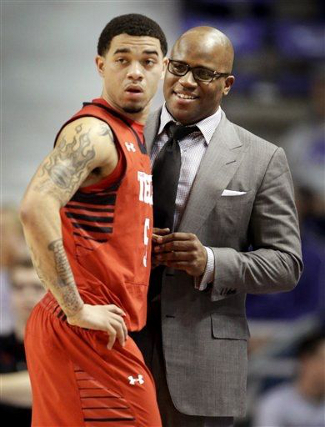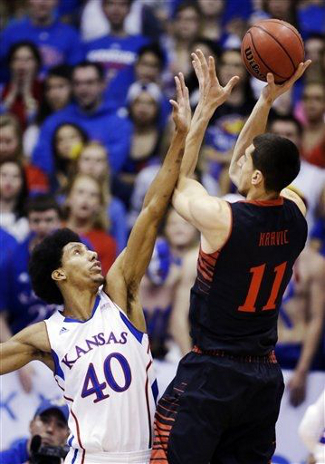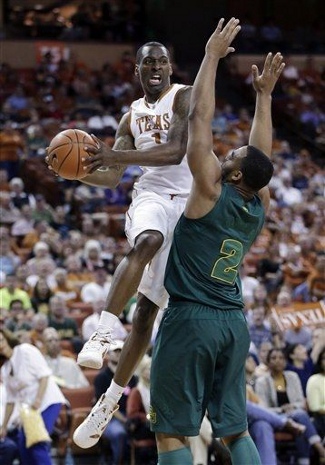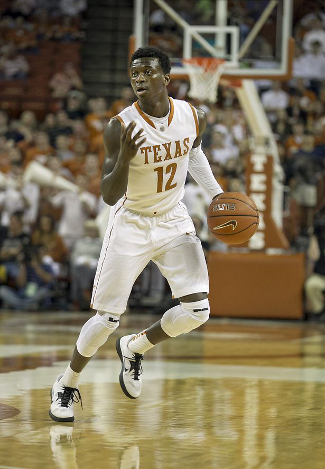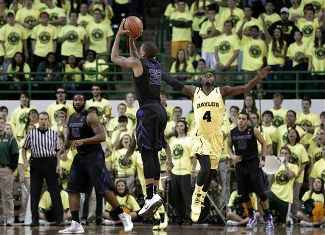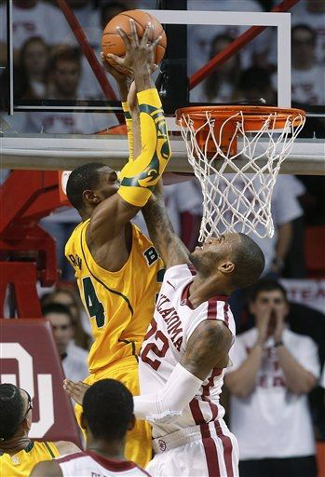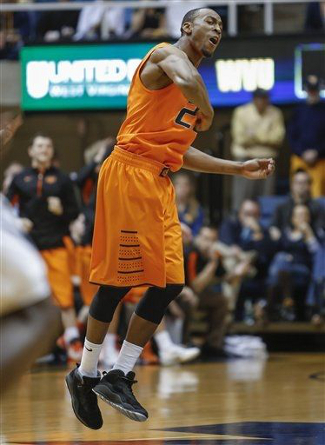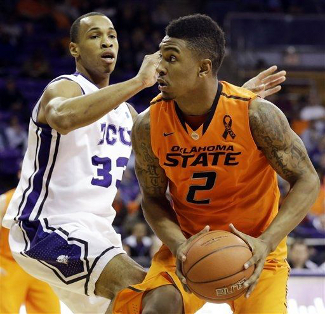Big 12 Championship First Round | Sprint Center | Kansas City, MO Tip: Approx. 8:30 P.M. CT | TV: Big 12 Network (Affiliate list) LRT Consecutive Game #252 The Texas Longhorns open play in the Phillips 66 Big 12 Championship with one, straightforward goal: win the whole damned thing. For the Longhorns, anything less than that will mean an end to a 14-year streak of NCAA appearances. And while Texas is hoping to preserve its historic streak, the rest of the program’s history is stacked against it. The Longhorns have never won the Big 12 Championship, despite appearing in the finals on six different occasions.
Rick Barnes and the Horns face an uphill battle in KC Even getting to that championship will be extremely difficult, as Texas must win three games in a row to reach that point. Until Saturday’s overtime win at Texas Tech, the Longhorns had not even strung together two consecutive victories in league play. Furthermore, Texas would still have to get past Kansas State and then either Oklahoma State or Baylor, three teams which the Horns posted a 1-5 record against in the regular season. Of course, the old adage holds that you must take it one game at a time. For Texas, that would be sage advice. Although the Horns open tournament play against last-place TCU, they have to remember that the Horned Frogs have pulled off surprising upsets to earn their two league victories. Earlier this season, TCU shocked the college basketball world with a home win over a Top 5 Kansas team. On Saturday, they wrapped up their regular season by building a massive lead against Oklahoma and then hanging on for the improbable win. If Texas makes the mistake of looking ahead to a possible matchup with Kansas State tomorrow night, the Horns might not even get there. Meet the Horned Frogs For an in-depth look at the TCU roster and the team’s style of play, check out LRT’s preview of the first match-up between these two teams. The first meeting Texas had to grind it out with TCU in the first game, which saw only 57 possessions on the night. Even with such a slow tempo, the Longhorns were able to build a lead as large as 19 points and won the game by a 17-point final margin. Texas used stifling defense to limit the already-anemic TCU offense to just 0.753 points per possession, while having one of its best shooting nights of the season on the other end. One reason Texas was able to get so many good looks is that the team made it a point to work the ball inside-out against TCU. Connor Lammert cracked double-digits in points for the first time in his collegiate career, logging 10 on a perfect 5-for-5 shooting night. Since then, the freshman has continued to play with confidence, earning starts in the team’s last two games. Ioannis Papapetrou also had a solid night against the Horned Frogs, scoring 13 points in his 34 minutes on the court. More importantly, the Greek forward snagged nine boards on a night where the Longhorns performed terribly on the glass. The Longhorns grabbed just 30 rebounds as a team, posting an ugly 26.9% mark on the offensive glass. For TCU, the bright spots were in the frontcourt, where Connell Crossland (No. 2) continued his surge in conference play. The senior had 12 rebounds, including four on the offensive end. Fellow big man Adrick McKinney (No. 24) led TCU in the scoring department with 13, while also logging eight boards. The rematch When the two teams squared off once again on February 19th, Myck Kabongo was back on the court for Texas, and he made an immediate impact. The sophomore point guard scored eight points in the first half and dished out five dimes, as the Longhorns took a 33-25 lead to the locker room. Texas moved the ball extremely well in the first half, while Kabongo was aggressive with the bounce. The Longhorns could have been even more efficient on offense, if not for a series of poor passes into the paint that resulted in turnovers. On the other end, the Longhorn defense had a tough time shutting down a TCU team that typically struggles to score. Even though Demarcus Holland did a solid job turning back the penetration of point guard Kyan Anderson (No. 5), the Horned Frog bigs repeatedly found great post position. Cameron Ridley especially struggled to force McKinney off the block, and he played only six minutes as a result. Even with that interior success, TCU did not limit its scoring to the paint, as Garlon Green repeatedly knocked down midrange jumpers. In the second half, TCU coach Trent Johnson made adjustments to slow down the Horns, most notably tabbing Nate Butler Lind (No. 21) to guard Kabongo. While he is perhaps a step slower than Anderson, Butler Lind’s extra length made it tougher for Kabongo to score, even when the Texas point guard was able to drive the lane. The Longhorns briefly experimented with a zone in the second half, but Anderson quickly took advantage without Holland in his shirt. Anderson penetrated the zone and hit his teammates in good position as the defense collapsed, logging six assists in the second half alone. He also chalked up some of those dimes by being alert after missed Texas shots, judiciously picking the spots where he could push the tempo for transition points. His leadership allowed the Horned Frogs to tie the game with just under nine minutes to go, and he kept them within a few buckets of Texas down the stretch. In the end, it was clutch plays from Connor Lammert and Holland that iced the game, keeping Texas just ahead of a determined TCU squad. After a pass by Kabongo from the opposite three-point line, Lammert made an acrobatic, backwards layup in transition as he was fouled, and then he converted the free throw. A few possessions later, Holland drilled a three from the corner as the shot clock neared zero. Thanks to those timely buckets, the Longhorns escaped Daniel-Meyer Coliseum with a 68-59 win, their first true road win of the season. Keys to the game 1) Clean up the glass – Although TCU is just an average rebounding team, the Longhorns had trouble keeping them away from the offensive boards in both games. Texas allowed the Horned Frogs to reclaim 37.8% of their misses in the first meeting between the two teams and 45.2% of their misses in the second game. The Horned Frogs do not shoot the basketball well and rely mostly on scoring from their bigs in the post. If the Horns wants to avoid the upset tonight, they have to take advantage of that offensive weakness by limiting second and third chances once they have forced missed shots.
Texas must challenge TCU big man Adrick McKinney 2) Make the bigs uncomfortable – With TCU’s preference for dumping it into the post, Texas has to make it a point to put the Horned Frog bigs in uncomfortable positions. (No, not the back of a Volkswagen.) The Longhorns can force TCU to make entry passes further up the lane or perhaps choose to immediately double on the catch near the block. With TCU hitting less than 31% of their threes on the season, the risk of doubling down is diminished greatly. No matter which approach is taken, the Horns have to focus on making things tough for McKinney and Devonta Abron (No. 23). The Longhorns also need to make sure that their interior fouls count, limiting the number of and-one opportunities they concede. At the line, TCU is the eighth-worst team out of 347 in the country, making less than 60% of their attempts. If the Horns are beat in the paint, they must make the Horned Frog bigs earn both of the points, not give up the two and still allow a chance for the bonus. 3) Aggression from the guards – TCU has a very stout defense that packs it in tight and forces opponents to beat them with outside and midrange shooting. In the last meeting, Kabongo showed how easily dribble penetration can make that TCU defense break down. The adjustment to put Butler Lind on Kabongo slowed down his attack, and it also slowed down the Horns as a result. If the Texas point guard is unable to mix things up with the bounce, Holland, Sheldon McClellan, and Julien Lewis will need to pick up the slack and drive from the wings and along the baseline. Otherwise, the Longhorns will be forced to win this game with their jump shots, and those have been very inconsistent all season long. |








